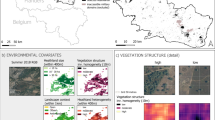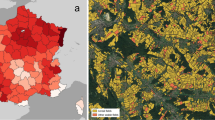Abstract
Radioactive contamination of agricultural land may necessitate long-term changes in food production systems, through application of selected countermeasures, in order to reduce the accumulation of radionuclides in food. We quantified the impact of selected countermeasures on habitat diversity, using the hypothetical case of two agricultural areas in Finland. The management scenarios studied were conversions from grassland to cereal production and from grassland and crop production to afforestation. The two study sites differed with respect to present agricultural production: one being predominantly cereal production and seminatural grasslands, while the other was dominated by intensive grass and dairy production. Some of the management scenarios are expected to affect landscape structures and habitat diversity. These potential changes were assessed using a spatial pattern analysis program in connection with geographic information systems. The studied landscape changes resulted in a more monotonous landscape structure compared to the present management, by increasing the mean habitat patch size, reducing the total habitat edge length and reducing the overall habitat diversity calculated by the Shannon diversity index. The degree of change was dependent on the present agricultural management practice in the case study sites. Where dairy production was predominant, the landscape structure changes were mostly due to conversion of intensive pastures and grasslands to cereal production. In the area dominated by cereal production and seminatural grasslands, the greatest predicted impacts resulted from afforestation of meadows and pastures. The studied management changes are predicted to reduce biodiversity at the species level as well as diminishing species-rich habitats. This study has predicted prominent side effects in habitat diversity resulting from application of management scenarios. These potential long-term impacts should be considered by decision-makers when planning future strategies in the event of radionuclide deposition.
Similar content being viewed by others
Author information
Authors and Affiliations
Rights and permissions
About this article
Cite this article
Luoto, M., Rekolainen, S., Salt, C. et al. Managing Radioactively Contaminated Land: Implications for Habitat Diversity. Environmental Management 27, 595–608 (2001). https://doi.org/10.1007/s002670010173
Issue Date:
DOI: https://doi.org/10.1007/s002670010173




